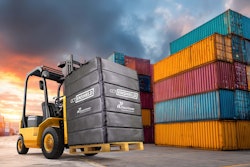
The performance of Beacon Converters/CardioFocus Heart Light® Cardiac Ablation system packaging system meets multiple objectives. First, it delivers a fragile, large, complex device intact and easily dispensed. Second, it utilizes a small mayo table—taking up less space in the specialized operating room by eliminating the need for a large prep table. Third, by reducing the packaging weight and volume compared with the conventional thermoformed tray with inserts, sustainability objectives are met.
The Flexible Packaging Assn. honored the pack with Gold Awards for Environmental and Sustainability Achievement, as well as for Technical Innovation.
The success of the package is best summarized by Al Stancampiano, director of product development at CardioFocus, “What we accomplished with this package was nothing short of a miracle. There were challenges in securing the fiber optic and tubing for transport while not doing damage and affecting its clinical performance, all combined with the need to have it easily release at the time of use.” CardioFocus is dedicated to the advancement of ablation treatments for cardiac disorders.
The die-cut trays are custom for each device and can be configured to work for catheter trays, surgical kits, and products in standard-sized or oversized trays, and long products that can be configured in a flexible tray.
The tray offers the medical community a flexible packaging option for large, complex devices, using less energy to manufacture, ship, and warehouse compared with a rigid PETG tray, reducing packaging volume by 32% and weight by 50%.
Functional components are cut from a single sheet of 0.035-in. flexible, recyclable high-density polyethylene. Key features include carabineer-style hold-downs that protect delicate device elements, and triangular sidewalls formed with a series of custom tabs that provide the tray’s physical structure. When assembled and loaded, this flexible packaging tray can be placed on a small mayo stand to allow positioning close to the sterile field, and acts as a catheter prep tabletop in the confined space of an Operating Room Angio-suite. After use, the tray knocks down flat and can be rolled up for recycling.
Beacon sells die-cut tray cards directly to device manufacturers. “Each is unique and completely customized for the device manufacturer’s product,” says Alison Tyler, technical director for Beacon Converters. The company manufactures them in a diverse range of sizes and configurations. She says, “We have tiny ones that fit in the palm of your hand, and ones like the CardioFocus tray that are over five feet long. Variations in features on the die cards are based on the specific needs of the device and what the packaging system needs to accomplish.”
The die-cut tray, although flexible, maintains necessary stiffness characteristics. From top to bottom, each design element has a specific critical function, and custom-developed features secure, stabilize, and protect delicate elements of the medical device through a rigorous distribution environment.
Throughout distribution and warehousing the flatness of the die-cut tray has space-saving advantages: 100 die-cut cards stack down to less than 4-in high. Space efficiencies translate to fewer corrugated boxes, reduced trucking, less fuel consumption to transport, and overall lower warehouse requirements. The triangular geometry of the tray sidewalls is formed during the loading process, using tabs along the tray’s length to maintain its shape. These sidewalls transform a flexible sheet of HDPE into a functionally rigid tray. After use the tray can be knocked down into its original flat format and compactly segregated into the recycle waste stream.
Traditionally, a cardio tray would have been packaged in ridged materials, including a heavy, bulky handle, a large fluid reservoir, and bending-sensitive fiber optics and tubing. For this CF tray, die-cutting is used to convert the single sheet of extruded HDPE into a final product with cut schemes that create a system of unitized features in just one step. The die-cut tray is assembled into its three-dimensional shape when the product is loaded. How unique is this package? “At this point, we are only aware of this package in the market that contains a complex device of this nature and size,” says Tyler. What differentiates it from other packaging? “While die-cut insert cards have been used to organize and protect devices, they have been repurposed into a flexible tray system.” Tyler adds, “Elements designed into the package like the carabineer hold-downs are completely custom and specific for this product, offering 360 degrees of protection with only one component, something that isn’t possible in a thermoform tray.”






















